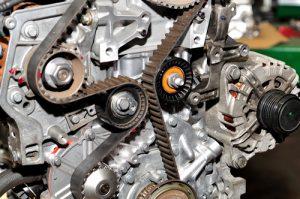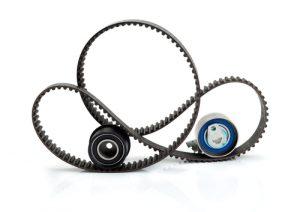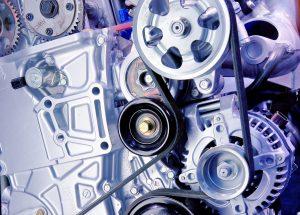The engine of a vehicle has plenty of various components that perform different functions. However, none of these parts would work had there been no drive belt. There are different types of car belts, and their job is to keep the engine running by transferring power to various parts.
They do this by having constant friction with several pulleys. For this reason, a loose or damaged belt affects the performance of the engine component related to it.
Contents
Types Of Car Belts: How Many Belts Does A Car Have?
How many belts are in a car? Several types and we are going to discuss some of the most common among them. Here’s a brief discussion of the standard belts in a car and how they work.
1. Timing Belts

Your timing belt is most likely the most crucial belt you own. It is what enables combustion inside the engine and ensures that everything is timed precisely.
Also known as a Gilmer belt and camshaft drive belt, the job of a timing belt is to help the crankshaft turn the camshaft. The rubber-made belt opens and closes engine valves with the pistons in a synchronized fashion.
In modern vehicles, this belt has taken the place of the timing chain. The failure of the belt causes less damage to the pistons and valves than to the belt.
2. Accessory Belts
The accessory belts come next. So what does the term “accessory” actually mean?
This indicates that the purpose of these belts is to power auxiliary parts that need to be powered in order to function.
Without a belt, the auxiliary units won’t work at all, and sooner or later your engine won’t have any power. Here are the two types of accessory belts you may want to take a look at!
V-Belts (Drive Belts)

Another types of car belts, one of the oldest supplementary belts, the V-belt was likely developed on vintage V8 pushrod engines. In order to power various components required for the engine to function correctly, these belts had to be created.
Originating from the crankshaft, they run through various components including the alternator, power steering pump, AC compressor, and water pump, and supply them with power to function. These are mostly seen in older cars.
These belts hardly slip from their circuit, and the failure of one belt does not affect all engine functions. However, all V-belts wear out almost at the same time.
So, you may have to replace all of them at the same time. Fluid contamination and regular wear and tear are the main reasons for the malfunction of these belts.
SEE MORE:

Serpentine Belts
A prolonged serpent-like belt runs through all engine components and powers them up. It is the alternative to multiple V-belts in newer cars. The belt is a standard in modern vehicles.
As a single belt supplies power to almost all engine accessories, multiple components will be affected if the belt loosens or gets damaged. However, it is easy to replace and you have to spend on only a single belt.
A failed serpentine belt creates a screeching or squeaking sound. When it fails, it may cause the entire engine to stop functioning.
Fan Belts
To be powered, the cooling system requires a belt. The serpentine belt drives it in certain engines. It is driven by the fan belt in other engines. The following components of the cooling system can be powered by it:
- Water meter
- Cooling fan
- Conditional air
A working fan belt does the following by driving the cooling system:
- Cool a radiator
- Coolant is pumped throughout the engine
Your engine will no longer be cooled if the fan belt snaps. The engine will overheat as a result, perhaps necessitating expensive repairs. Therefore, it seems sensible to examine the fan belt during regular inspections.
Drive Belt Vs Serpentine Belt
Among all types of car belts, there is no difference between a drive belt and a serpentine belt. Most cars have one or two drive belts. It is also called a serpentine belt when there is only one drive belt in a car.
Whether it is a drive or serpentine belt, it is a part of the accessories that drive a car’s engine. The rubber-made component lasts for a long time, something between 40,000 and 70,000 miles.
However, it is not rare to see them lasting for more than 100 thousand miles.

FAQs on Types of Car Belts
-
Can I install a timing belt at home?
Timing belt installation is not something you can perform straight away. Even seasoned technicians won’t allow unskilled apprentices to cause a mess when changing timing belts.
The engine will not be accurately timed even if the timing is just off by a few millimeters during timing belt installation, and engine damage will result.
Depending on how serious of a mistake you made, the valves will be smashed. Therefore, if you lack the necessary education and skills to perform this task, don’t attempt it at home.
However, changing a serpentine or V-belt is a simple task that anybody can complete without risk. Just make sure you remove the old belt and attach the new one in the same manner.
-
When should you change these types of car belts?
The belts in your automobile need to be updated, just like every other component. It makes no difference if you are using a timing belt, serpentine belt, or V-belt.
Every belt has a chance of breaking. especially the less expensive choices made by certain lesser-known firms.
To be more specific, how many miles do they last? Well, a lot depends on how old the belt is.
As you may already be aware, rubber, which is used to make belts, hardens with time. As a result, belts can break even when they are not too worn out.

This is also crucial because the teeth keep the timing belt in the proper position. The timing will be thrown off if the belt jumps, and engine damage may result. Pay close attention to these timing belt components as a result.
Additionally, at 60,000 miles, auxiliary belts must be changed. Even if the belt snaps, you won’t damage the engine, thus replacing them is not critical.
However, the vehicle will finally turn off. In the worst scenarios, it can potentially overheat. Nevertheless, it is advisable to make sure that it is changed promptly.
-
What does it cost for a car belt to change?
The timing belts will be our first mention. When it comes to cost, these belts are the most expensive to replace.
The component itself is reasonably priced and may be obtained for $50 to $100. However, labor is expensive, and the total cost of labor and components for a timing belt repair can range from $400 to $600.
On the other hand, serpentine belts are easier to change and cost less than $300 to do so (labor and components).
-
What happens if you don’t change these belts on cars?
Let’s take a look at what might happen if you don’t change the various sorts of automobile belts in your vehicle. As previously stated, the timing belt controls the engine’s timing. As a result, if the belt is broken or breaks.
The timing will be disrupted, and your engine will most likely suffer engine damage. Because these engines with timing belts are interference engines.
If a belt snaps in a non-interference engine, the potential harm is minimal. What, exactly, are non-interference engines?
These are the engines that do not use an overhead camshaft mechanism. More specifically, pushrod V8 engines. Because they are chain-driven and non-interference, they are largely damage-proof in situations like these.
Check out this video from Scotty Kilmer to learn more about Belt squeal, squeaky belt, belt noise and drive belt replacement!
Final Words
In the end, these are common types of car belts you may want to acknowledge for today.
The engine’s good health and operation mostly depend on the condition of these belts. So remember each one and their functions to use them in the best way possible.
Overall, timing belts, V-belts, and serpentine belts are all common. The timing belt drives the engine, while serpentine and V-belts power accessories like the air conditioning system, water pump, alternator, and other vital parts required for the operation of the vehicle. Simple as that!



